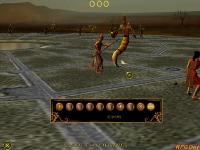| |
 Site Navigation
Site Navigation
Main
News
Forums
Games
Games Database
Top 100
Release List
Support Files
Features
Reviews
Previews
Interviews
Editorials
Diaries
Misc
Download
Gallery
Music
Screenshots
Videos
Miscellaneous
Staff Members
Privacy Statement
|
 |
|
|
MC_Renzy
Fearless Paladin

Joined: 04 Nov 2001
Posts: 226
|
| Cluster Size For Hard Drive |
|
How does one go about changing the cluster size of the main drive during a DOS format? I tried using those 3rd party programs to change the clusters , but I couldn't get them to work properly. Is there some sort of DOS command that can do this or is it in the options while DOS formatting? I tried formatting it in Windows XP where it actually allows you to select the cluster sizes, but it won't format it because the drive is in use by Windows. It just gives me an error. So DOS is the only way, but I am not sure how I would go about changing the clusters in DOS. Right now I'm running as NTFS with a cluster size of 512bytes. I want to change this to 4K. Appreciate any info. |
 Wed Jun 29, 2005 7:19 am
Wed Jun 29, 2005 7:19 am |
|
|
Danicek
The Old One

Joined: 15 Dec 2001
Posts: 5922
Location: Czech Republic |
It depends on what Windows version you use.
The command to do partitioning from DOS prompt was fdisk.
See
http://www.computerhope.com/fdiskhlp.htm
for more details. |
 Wed Jun 29, 2005 7:48 am
Wed Jun 29, 2005 7:48 am |
|
|
Val
Risen From Ashes

Joined: 18 Feb 2002
Posts: 14724
Location: Utah, USA |
FDISK doesn't let you change the cluster size. The only DOS command that I remember that let's you change the cluster size is FORMAT.
EDIT: I just dug through my old DOS desk reference. Yes, FORMAT is the only command that changes the cluster size. But the problem is that you don't get to choose the cluster size. FORMAT chooses it based on the size of the logical drive. You'll have to look elsewhere if you want to pick the size of the clusters. The only DOS solution would be to create several small partitions.
_________________
Freeeeeeedom! Thank heavens it's summer!
What do I have to show for my hard work? A piece of paper! Wee!
=Guardian, Moderator, UltimaDot Newshound=  |
 Wed Jun 29, 2005 7:01 pm
Wed Jun 29, 2005 7:01 pm |
|
|
Danicek
The Old One

Joined: 15 Dec 2001
Posts: 5922
Location: Czech Republic |
It seems I mistake cluster size and partitions. |
 Thu Jun 30, 2005 7:59 am
Thu Jun 30, 2005 7:59 am |
|
|
MC_Renzy
Fearless Paladin

Joined: 04 Nov 2001
Posts: 226
|
quote:
Originally posted by Val
FDISK doesn't let you change the cluster size. The only DOS command that I remember that let's you change the cluster size is FORMAT.
EDIT: I just dug through my old DOS desk reference. Yes, FORMAT is the only command that changes the cluster size. But the problem is that you don't get to choose the cluster size. FORMAT chooses it based on the size of the logical drive. You'll have to look elsewhere if you want to pick the size of the clusters. The only DOS solution would be to create several small partitions.
Not sure where else to look. Ever since converting to ntfs, I've been stuck at 512bytes as opposed to 4k when at fat 32. My drive is much slower now because of this. I tried using Partition Magic to do the job, but had nothing but problems. Any other way? |
 Thu Jun 30, 2005 3:33 pm
Thu Jun 30, 2005 3:33 pm |
|
|
Moriendor
Black Ring Leader

Joined: 19 Jul 2001
Posts: 1306
Location: Germany |
This link here is pretty good, especially the links at the bottom and this bit here which might explain why your drive has slowed down:
quote:
If you did not setup Windows on the newly created NTFS Volume, but converted volume from FAT to NTFS, usually it causes MFT fragmentation so generally converted partitions are much slower than the ones being originally created as NTFS. Defragmentation tools are in general unable to defragment MFT, however, you can try to backup the whole system, re-format the volume with proper cluster size, and restore it back.
|
 Thu Jun 30, 2005 10:25 pm
Thu Jun 30, 2005 10:25 pm |
|
|
Val
Risen From Ashes

Joined: 18 Feb 2002
Posts: 14724
Location: Utah, USA |
You might find this link useful as well.
_________________
Freeeeeeedom! Thank heavens it's summer!
What do I have to show for my hard work? A piece of paper! Wee!
=Guardian, Moderator, UltimaDot Newshound=  |
 Thu Jun 30, 2005 11:44 pm
Thu Jun 30, 2005 11:44 pm |
|
|
Amelia
City Guard

Joined: 18 Jun 2004
Posts: 141
Location: Ong's Hat, New Jersey |
Insert your XP cd at boot (make sure you have cd drive set to be read first - option accessed through bios). Should bring up a bootapp where you'll want to choose 'setup' or install windows as opposed to repair. I haven't done this in a moment but the gist is, you'll hit a screen where you'll be able to format your current drive (make sure you're backedup) and designate partitions (where you can change clusters). If you have data you might not want to lose, don't do anything you aren't sure of - generally a good idea anyways.
Edit: Or Val's link.
_________________
The real secret of magick is that the world is made of words. And that if you know the words that the world is made of, you can make of it whatever you wish. -Terence Mckenna |
 Fri Jul 01, 2005 4:58 am
Fri Jul 01, 2005 4:58 am |
|
|
MC_Renzy
Fearless Paladin

Joined: 04 Nov 2001
Posts: 226
|
So, using a boot disk and typing in "Format C: /a:4K" would do the job? |
 Fri Jul 01, 2005 7:04 am
Fri Jul 01, 2005 7:04 am |
|
|
|
All times are GMT. The time now is Wed Apr 10, 2019 12:55 pm
|
|
|
|
|
|
|






